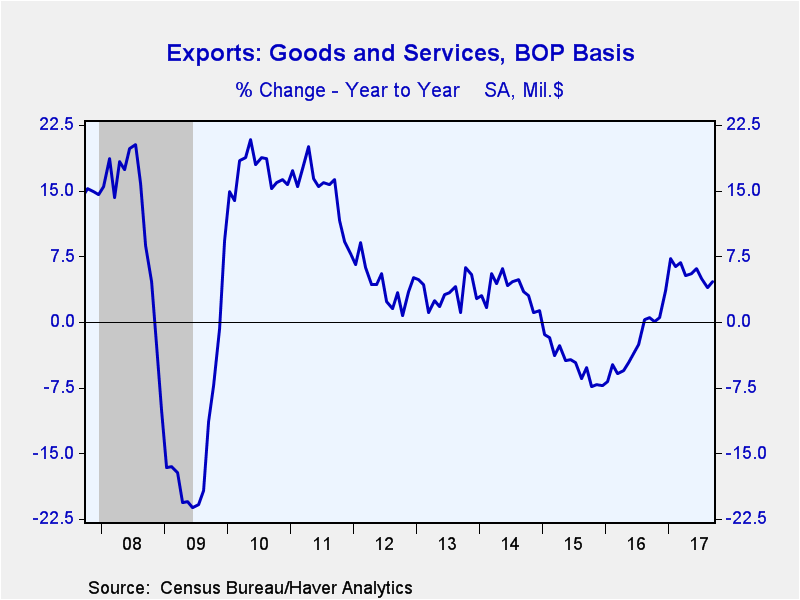 Global| Nov 03 2017
Global| Nov 03 2017U.S. Trade Deficit Widens in September; Exports Improve, Imports Rebound
by:Sandy Batten
|in:Economy in Brief
Summary
The U.S. trade deficit in goods and services widened to $43.5 billion in September from a slightly upwardly revised $42.8 billion shortfall in August. A $43.2 billion deficit had been expected in the Action Economics Forecast Survey. [...]
The U.S. trade deficit in goods and services widened to $43.5 billion in September from a slightly upwardly revised $42.8 billion shortfall in August. A $43.2 billion deficit had been expected in the Action Economics Forecast Survey. Total exports increased 1.1% m/m (4.6% y/y) after a downwardly revised 0.1% m/m increase in August. Imports rebounded, led by non-petroleum products, rising 1.2% m/m (6.1% y/y) in September following a slightly downwardly revised 0.2% m/m decline in August. This was the first monthly increase in imports in the past five months.
The widening of the overall deficit in September was due mainly to trade in goods. The goods deficit widened to $65.4 billion in September from $64.8 billion in August, the services surplus narrowed marginally to $21.9 billion from $22.0 billion. For the first nine months of 2017, the overall trade deficit totaled $405.2 billion, up significantly from $370.7 billion over the first nine months of 2016.
The pickup in September exports mostly reflected a rise in goods exports (+$2.1 billion, 1.6% m/m, 4.9% y/y), which was dominated by a $1.1 billion increase in crude oil exports. The rise in crude oil exports comprised 52% of the overall rise in goods exports in September. Goods exports in other end-use categories were generally weak: capital goods exports fell 0.5% m/m; automotive exports slumped 1.4% m/m; and exports of non-auto consumer goods declined 1.3% m/m. Service exports edged up on $0.3 billion (0.4% m/m, 4.5% y/y). This was completely accounted for by a $0.3 billion rise in the export of transport services.
The rebound in imports was again due mostly to goods ($2.5 billion, 1.2% m/m, 6.5% y/y), the September rise was totally accounted for by increases in imports of capital goods ($1.5 billion, 2.7% m/m, 13.0% y/y) and imports of industrial supplies and materials ($1.1 billion, 2.7% m/m, 8.1% y/y). Automotive imports fell 1.8% m/m (-1.1% y/y) in September, which essentially offset modest increases in food imports and non-auto consumer goods imports. Nonpetroleum goods imports rebounded in September, rising 1.2% m/m (6.1% y/y) following a 0.6% m/m drop in August. Petroleum imports rose 2.6% m/m (11.1% y/y) in September but this was a marked slowdown from the 5.1% m/m rise posted in August notwithstanding a further 2.4% m/m increase in the price per barrel of crude petroleum.
Services imports revived in September, increasing 1.0% m/m ($0.4 billion, 4.6% y/y) following a 0.6% m/m decline in August. Apart from "Other business services", imports of all other end-use categories experienced monthly increases in September, led by imports of transport services (+3.1% m/m).
By country, the goods trade deficit with China (not seasonally adjusted ) narrowed slightly to $34.6 billion in September from $34.9 billion in August but was wider than the $32.5 billion deficit reported one year earlier. Export growth slowed to 13.6% y/y from 16.6% while import growth picked up to 8.1% y/y from 6.0%. The trade deficit with the European Union (again NSA) widened to $10.8 billion in September from $9.3 billion one year earlier. Export growth to the EU fell to 3.8% y/y from 9.4% y/y in August while import growth accelerated to 8.4% y/y from essentially unchanged in August.
The international trade data can be found in Haver's USECON database. Detailed figures are available in the USINT database. The expectations figures are from the Action Economics Forecast Survey, which is carried in AS1REPNA.
| Foreign Trade in Goods & Services (Current Dollars) | Sep | Aug | Jul | Y/Y | 2016 | 2015 | 2014 |
|---|---|---|---|---|---|---|---|
| U.S. Trade Deficit | $43.5 bil. | $42.8 bil. | $43.6 bil. | $38.5 bil. (9/16) |
$504.8 bil. | $500.4 bil. | $490.3 bil. |
| Exports of Goods & Services (% Chg) | 1.1 | 0.1 | -0.2 | 4.6 | -2.5 | -4.7 | 3.6 |
| Imports of Goods & Services (% Chg) | 1.2 | -0.2 | -0.2 | 6.1 | -1.9 | -3.6 | 4.0 |
| Petroleum (% Chg) | 2.6 | 5.1 | -7.1 | 11.1 | -19.4 | -45.5 | -9.7 |
| Nonpetroleum Goods (% Chg) | 1.2 | -0.6 | 0.3 | 6.1 | -1.2 | 2.2 | 6.5 |
Sandy Batten
AuthorMore in Author Profile »Sandy Batten has more than 30 years of experience analyzing industrial economies and financial markets and a wide range of experience across the financial services sector, government, and academia. Before joining Haver Analytics, Sandy was a Vice President and Senior Economist at Citibank; Senior Credit Market Analyst at CDC Investment Management, Managing Director at Bear Stearns, and Executive Director at JPMorgan. In 2008, Sandy was named the most accurate US forecaster by the National Association for Business Economics. He is a member of the New York Forecasters Club, NABE, and the American Economic Association. Prior to his time in the financial services sector, Sandy was a Research Officer at the Federal Reserve Bank of St. Louis, Senior Staff Economist on the President’s Council of Economic Advisors, Deputy Assistant Secretary for Economic Policy at the US Treasury, and Economist at the International Monetary Fund. Sandy has taught economics at St. Louis University, Denison University, and Muskingun College. He has published numerous peer-reviewed articles in a wide range of academic publications. He has a B.A. in economics from the University of Richmond and a M.A. and Ph.D. in economics from The Ohio State University.










